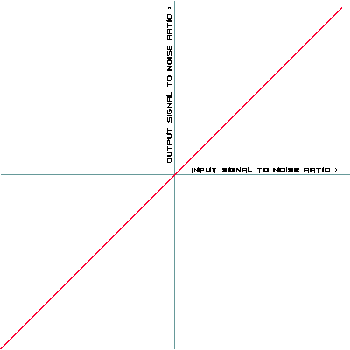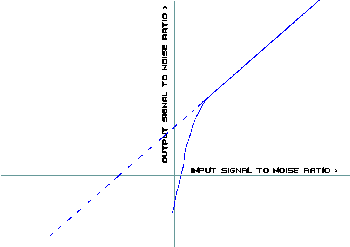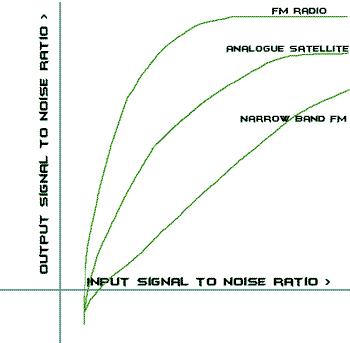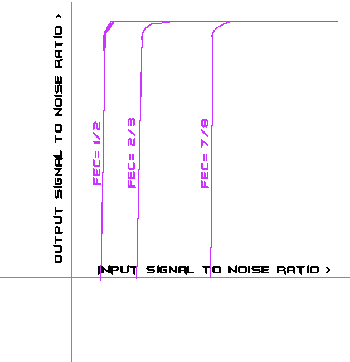What's a threshold, and why should I care?
What's Claude Shannon got to do with all this anyway?
No maths here, but there will be some graphs (all drawn with my shaky hand).
To understand what a threshold is we need a couple of definitions.
Input signal to noise ratio: the ratio of the incoming wanted radio signals
to that of any interfering radio signals and noise - normally expressed in decibels
(dB). This is sometimes referred to as the carrier to noise ratio (C/N) for
analogue systems and energy per bit to noise ratio (Eb/no) for digital ones.
Output signal to noise ratio: the ratio of the demodulated wanted signal to
the demodulated noise and interference - - normally expressed in decibels (dB).
At first sight perhaps we think we know how our system will behave, surely
it must be like this!

As the input signal to noise ratio changes, so does the output signal to noise
ratio, and at the same rate too.
There are radio signals that behave like this: single sideband and Morse code
signals. These are the kind of radio transmissions that radio amateurs use.
By straining their ears, they can hear voices and especially Morse code, even
when the output signal to noise ratio is negative and the signal is deeply buried under lots
of noise and interference, long after the point that mere ordinary mortals like
me would have given up on the whole deal.
Now let's look at a signal we're more familiar with, ordinary AM radio signals,
available on every domestic radio.

Something strange, starts to happen, the output signal to noise ratio is better
than the input signal to noise ratio! In fact it's 3dB better!
If we had a professional radio, with a product detector, the demodulated signal
would follow the dotted line as the input signal to noise ratio got worse and
worse. But your radio probably uses a cheaper diode detector as the demodulator,
and there comes a point where the signal is not large enough to switch the diode
in and out of conduction properly. At this point the signal rapidly disappears
into a mess of noise and distortion, following the solid blue line instead.
The point at which the solid line swerves off the straight line is called the
threshold. Being really picky, the threshold is generally defined as being the
point at which the signal to noise ratio has worsened by 1dB from the straight
line.
But where did the 3dB improvement come from?
It came from the fact that these AM signals have twice the bandwidth of the
single sideband signal we looked at earlier. We've now got twice the signal,
gaining us 6dB more signal voltage at the demodulator. But we've also got twice
the noise bandwidth. Luckily the noise is random; meaning that the noise in
one sideband is uncorrelated with the noise in the other sideband, so the noise
doesn't add up arithmetically like the signal did. It works out that the noise
is only 3dB more than before so, on balance, we've won ourselves 3dB!
We've just learned that communications systems can suffer from threshold effects
that are affected by how we demodulate the signal, and that it's possible for
the output signal to noise ratio to be better or worse than the input signal
to noise ratio.
Can we do better than this? We surely can! Lets look at broadcast FM radio
and analogue satellite TV (which is also FM).

Three lines here, for different amounts of FM modulation. The top one is like
broadcast FM radio, which uses oodles of bandwidth and can give really massive
amounts of signal to noise ratio improvement. It has a pretty definite threshold
point too. This is responsible for the chuffing noise that you sometimes hear
when listening to a weak station on the FM band. A very slight change in the
received signal level can cause the input signal to noise ratio to drop beneath
the threshold point, leaving you with only a hissing fizzing mess. Oddly enough,
the better the demodulator your radio has, the worse this sounds!
The middle line shows the way analogue satellite signals behave, there is still
a threshold, but it's not so definite. You can now watch signals some way below
the threshold point, provided you don't mind a few sparklies. With some cunning
kind of threshold extension device fitted in your receiver's demodulator, you
can sometimes tweak the threshold point of your system to the point that the
sparklies may even disappear again.
The bottom line shows low deviation FM, which uses the same amount of bandwidth
as AM, and not surprisingly, the resulting graph is very similar to the AM one.
OK, now its time to go digital!

What does this show us?
1. Digital signals exhibit a definite and violent threshold effect, going from
perfection to useless over a very small difference in input signal to noise
ratio.
2. All you need is enough signal. Once you have a good signal above the threshold
point, improving the input signal to noise ratio does not give you a better
picture. It does, however, buy you a better protection margin so you can keep
watching on those rainy days!
3. If you are only just a little bit below the threshold and suffering pixellation,
juddering, freezing pictures, a small improvement in input signal to noise ratio
is all you need to enjoy a perfect picture. Go out and tweak that dish now!
4. The error correction ratio, the FEC, makes a big difference to where the
threshold point sits. Major broadcasters use FEC ratios of 2/3 or 3/4. These
ratios produce significantly lower thresholds for their viewers, allowing them
to use smaller dishes. Non-broadcast satellite feeds however, use 5/6 or 7/8
FEC ratios, which makes them harder to watch without using a much bigger dish.
Can we do better than the present digital modulation systems?
That's good question, which deserves a good answer. Unfortunately I'm not clever
enough to give you one! Let me tell you a bit about Claude Shannon instead.
Claude Shannon was a really clever guy working at Bell Labs in the USA in the
1940's. From his work we know how the input and the output signal to noise ratios,
the channel bandwidth, and the way the signal is encoded or modulated are all
related to each other.
What his equations don't do, however, is tell us how to build a system that
lets us trade one of these variables off against the others. They just let you
see how well you've done compared with the theoretical maximum you could have
got if you had done it properly.
Communications theory is really fascinating, but brain boiling, stuff.
Consider the following two messages.
"The pub has got lots of beer"
"The pub has not got any beer"
They both have the same number of characters, which are chosen from the same
character set, so they, at first glance, must be carry the same amount of information.
But they don't.
One message is much more unexpected than the other, and for that reason alone,
contains much more information!
Could this be the start of an article about mpeg coding?
The Professor
|